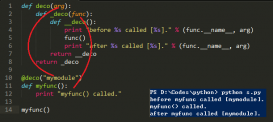在正式开始Web开发前,我们需要编写一个Web框架。
为什么不选择一个现成的Web框架而是自己从头开发呢?我们来考察一下现有的流行的Web框架:
- Django:一站式开发框架,但不利于定制化;
- web.py:使用类而不是更简单的函数来处理URL,并且URL映射是单独配置的;
- Flask:使用@decorator的URL路由不错,但框架对应用程序的代码入侵太强;
- bottle:缺少根据URL模式进行拦截的功能,不利于做权限检查。
所以,我们综合几种框架的优点,设计一个简单、灵活、入侵性极小的Web框架。
设计Web框架
一个简单的URL框架应该允许以@decorator方式直接把URL映射到函数上:
|
1
2
3
4
5
6
7
8
9
10
|
# 首页:@get('/')def index(): return '<h1>Index page</h1>'# 带参数的URL:@get('/user/:id')def show_user(id): user = User.get(id) return 'hello, %s' % user.name |
有没有@decorator不改变函数行为,也就是说,Web框架的API入侵性很小,你可以直接测试函数show_user(id)而不需要启动Web服务器。
函数可以返回str、unicode以及iterator,这些数据可以直接作为字符串返回给浏览器。
其次,Web框架要支持URL拦截器,这样,我们就可以根据URL做权限检查:
|
1
2
3
4
5
6
|
@interceptor('/manage/')def check_manage_url(next): if current_user.isAdmin(): return next() else: raise seeother('/signin') |
拦截器接受一个next函数,这样,一个拦截器可以决定调用next()继续处理请求还是直接返回。
为了支持MVC,Web框架需要支持模板,但是我们不限定使用哪一种模板,可以选择jinja2,也可以选择mako、Cheetah等等。
要统一模板的接口,函数可以返回dict并配合@view来渲染模板:
|
1
2
3
4
|
@view('index.html')@get('/')def index(): return dict(blogs=get_recent_blogs(), user=get_current_user()) |
如果需要从form表单或者URL的querystring获取用户输入的数据,就需要访问request对象,如果要设置特定的Content-Type、设置Cookie等,就需要访问response对象。request和response对象应该从一个唯一的ThreadLocal中获取:
|
1
2
3
4
5
6
|
@get('/test')def test(): input_data = ctx.request.input() ctx.response.content_type = 'text/plain' ctx.response.set_cookie('name', 'value', expires=3600) return 'result' |
最后,如果需要重定向、或者返回一个HTTP错误码,最好的方法是直接抛出异常,例如,重定向到登陆页:
|
1
|
raise seeother('/signin') |
返回404错误:
|
1
|
raise notfound() |
基于以上接口,我们就可以实现Web框架了。
实现Web框架
最基本的几个对象如下:
|
1
2
3
4
5
6
7
8
9
10
11
12
13
14
15
16
17
18
19
20
21
22
23
24
25
26
27
28
29
30
31
32
33
34
35
36
37
38
39
40
41
42
43
44
45
46
47
48
49
50
51
52
53
54
55
56
57
58
59
60
61
62
63
64
65
66
67
68
69
70
71
72
73
74
75
76
77
78
79
80
|
# transwarp/web.py# 全局ThreadLocal对象:ctx = threading.local()# HTTP错误类:class HttpError(Exception): pass# request对象:class Request(object): # 根据key返回value: def get(self, key, default=None): pass # 返回key-value的dict: def input(self): pass # 返回URL的path: @property def path_info(self): pass # 返回HTTP Headers: @property def headers(self): pass # 根据key返回Cookie value: def cookie(self, name, default=None): pass# response对象:class Response(object): # 设置header: def set_header(self, key, value): pass # 设置Cookie: def set_cookie(self, name, value, max_age=None, expires=None, path='/'): pass # 设置status: @property def status(self): pass @status.setter def status(self, value): pass# 定义GET:def get(path): pass# 定义POST:def post(path): pass# 定义模板:def view(path): pass# 定义拦截器:def interceptor(pattern): pass# 定义模板引擎:class TemplateEngine(object): def __call__(self, path, model): pass# 缺省使用jinja2:class Jinja2TemplateEngine(TemplateEngine): def __init__(self, templ_dir, **kw): from jinja2 import Environment, FileSystemLoader self._env = Environment(loader=FileSystemLoader(templ_dir), **kw) def __call__(self, path, model): return self._env.get_template(path).render(**model).encode('utf-8') |
把上面的定义填充完毕,我们就只剩下一件事情:定义全局WSGIApplication的类,实现WSGI接口,然后,通过配置启动,就完成了整个Web框架的工作。
设计WSGIApplication要充分考虑开发模式(Development Mode)和产品模式(Production Mode)的区分。在产品模式下,WSGIApplication需要直接提供WSGI接口给服务器,让服务器调用该接口,而在开发模式下,我们更希望能通过app.run()直接启动服务器进行开发调试:
|
1
2
3
4
5
6
7
8
9
10
11
12
13
14
15
16
17
18
19
20
21
22
23
24
25
26
27
28
29
30
31
32
33
34
35
36
37
38
39
40
41
|
wsgi = WSGIApplication()if __name__ == '__main__': wsgi.run()else: application = wsgi.get_wsgi_application()因此,WSGIApplication定义如下:class WSGIApplication(object): def __init__(self, document_root=None, **kw): pass # 添加一个URL定义: def add_url(self, func): pass # 添加一个Interceptor定义: def add_interceptor(self, func): pass # 设置TemplateEngine: @property def template_engine(self): pass @template_engine.setter def template_engine(self, engine): pass # 返回WSGI处理函数: def get_wsgi_application(self): def wsgi(env, start_response): pass return wsgi # 开发模式下直接启动服务器: def run(self, port=9000, host='127.0.0.1'): from wsgiref.simple_server import make_server server = make_server(host, port, self.get_wsgi_application()) server.serve_forever()Try |
把WSGIApplication类填充完毕,我们就得到了一个完整的Web框架。












